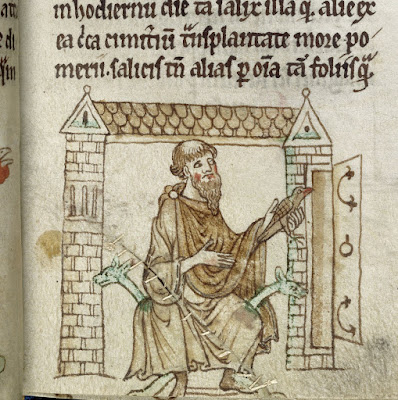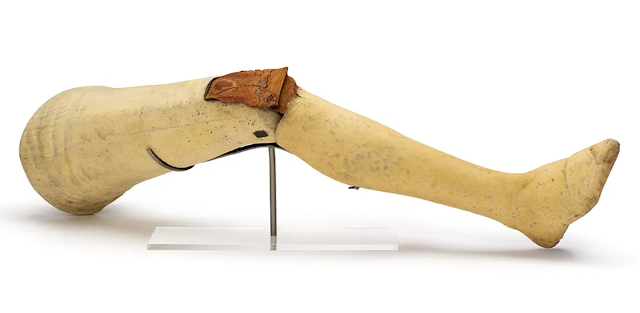OBSCURE SAINTS - St Kevin
 |
| MS Royal 13 B VIII, Gerald of Wales' Topographia Hiberniae, England, c.1196-c.1223 |
The website
TV Tropes is one which, like Wikipedia, is easy to venture into, and then find
yourself going down a metaphorical rabbit hole.
One of its features is that each trope often has a name drawn from one
of the works which has used it.
One trope is Aerith and Bob – the usage of very common-sounding names amongst more fantastical
ones – which creates a sense of dissonance.
Even when justified by the story line (such
as a character from the 20th century being catapulted into a pseudo-medieval
fantasy world) if creates a certain degree of dissonance. It is worth noting that the definition excludes those cases where this is deliberate or a translation convention in the manner of Tolkien's use of different historical languages for different culture. When reading down a list of medieval saints
the appearance of Saint Kevin might produce the same effect.*
St Kevin in
this case is a modern Anglicisation of the Old Irish Cóemgen (Caoimhín in Modern Irish) – a name which is
latinized as Coemgenus. St Kevin’s life is not particularly well
documented as there are no contemporaneous sources in which he appears. There is however a Latin Life from the
later Middle Ages preserved amongst later records – which appears in the Acta
Sanctorum Hiberniae edited together by John Colgan in 1645. A contemporary of St Cronan of Roscrea – Kevin’s
birth date is uncertain (even by medieval standards) but legend places it AD 498
– his death is recorded as being 3rd June 618 (which is now his
saint’s day). His name implies noble birth (translating in Old Irish as ‘fair-begotten’. There is some suggestion that he was a pupil
of St Petroc – but this is not present in the later medieval Life nor in
the early modern hagiography. This
long life, give or take ten years, is by no means impossible – the concept that medieval people had very
low life expectancies is an unfortunate myth based on a misinterpretation of
the evidence. Firstly the general
medieval population is uncertain at best, but secondly calculations of average
life expectancy can be lowered ‘artificially’ due to high rates of infant
mortality. There are reliable records of
a number of long lived individuals in the medieval period – but it should also
be noted that longevity is a frequent element of hagiography – particular of
saints who dwell in isolation from the world.
Another example of a particularly long lived is St Gilbert of
Sempringham, the founder of the Gilbertine Order which flourished in England
between its foundation in 1130 and the Dissolution of the Monasteries in which
began in 1536 – during which time it weathered a number of localised scandals
including a dispute within Gilbert’s life time (when he was around 90) which
ended in Rome upon a judgement from Pope Alexander III. Given these examples it is on balance possible
that St Kevin lived a long life – but there is no real certainty of just how long.
St Kevin lived as a hermit in a Bronze Age
tomb now referred to as St Kevin’s Bed, cut into a mountain in what is modern
day County Wicklow, Ireland. A monastic
community at Glendalough – the surrounding area – grew up and was apparently
well established by AD 540. St Kevin is
described as a famous, but as with many medieval hermits, reluctant teacher –
and once his community was established he retreated into solitude again. St Kevin is described as having visited St
Columba and St Comgall, amongst others, in AD 544 in what is modern Westmeath –
however this is unlikely. An outbreak of
some form of disease had caused this particular group to disperse, and Columba
had returned to Ulster in this year – so while it may be possible, it is
unlikely that St Columba was present.
The tomb in which St Kevin lived was later used by St Lawrence O'Toole (Lorcán Ua Tuathail), in the twelfth century. St Lawrence came to prominence within the news media outside Ireland when in March 2012 the relic of his heart was stolen in mysterious circumstances from Christ Church Cathedral in Dublin and again when in 2018 when it was returned under equally mysterious circumstances. To date (2020) the case is still classed as open and ongoing.
St Kevin was
canonised by Pope Pius X in 1903 – and to most modern audiences outside Ireland
is probably known only from passing references in the work of James Joyce, and
the poem 'St Kevin and the Blackbird', by Seamus Heaney. Heaney’s poem recounters one of the more colourful
episodes in the Saint’s life – in which, while the saint is at prayer for long
hours a blackbird build a nest in his outstretched hand, which he continued to
hold there until the blackbird’s young are grown enough to move on. You can
listen to Heaney’s reading of the poem here.
(*) On a
personal note – this gave me a mental image of a puppet Gerbil dressed as a monk – which
is a 1980s breakfast television reference which might be familiar to British
audiences – and mind boggling to everyone else, for which I apologise.


